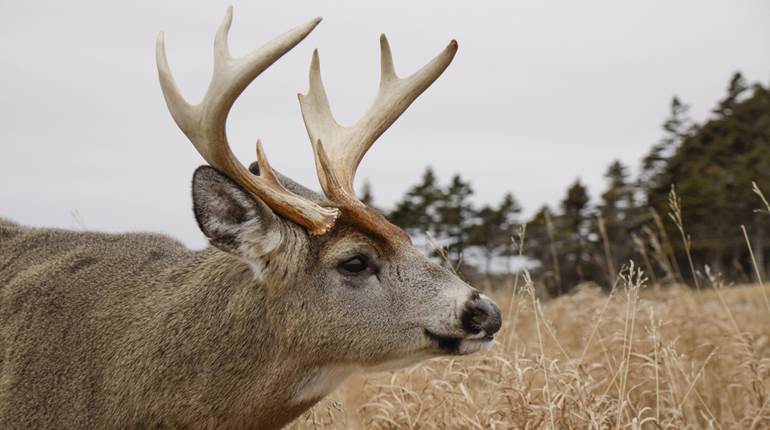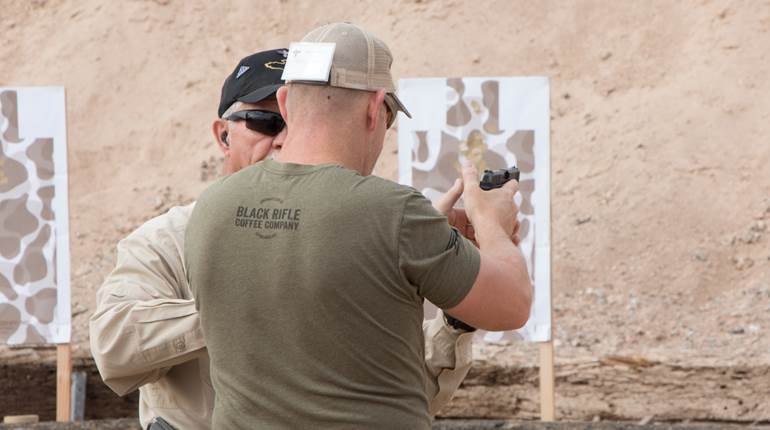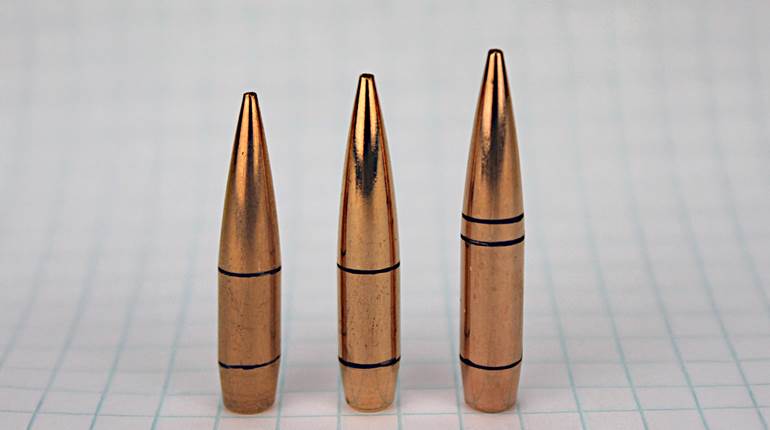
This article, "Pro Rifle Handling: Practice With The Big Boys" by Joe Coogan, appeared originally in the February 2006 issue of American Rifleman. To subscribe to the magazine, visit the NRA membership page and select American Rifleman as your member magazine.
When I glanced to my left, I recognized murder in motion. The brush cracked, giving way to a vicious sweep of horn carried on the business end of a Cape buffalo as he charged straight at us. Conscious thought did not interfere with the urgency of stopping the buff—as I pulled the trigger I knew there was no margin for error—he was too close.
The element of danger adds a whole new dimension to hunting, and it demands a healthy dose of caution and respect backed by knowledge and experience. Fortunately, I stopped that charging buff with a single shot before he plowed through our group of five people. The shot drove a 500-gr., solid .458 bullet through the brute’s brain—his nose shoveling into the ground seven feet from where we stood.
Africa’s “Big Five” (elephant, rhino, buffalo, lion and leopard), and the big bears of North America (brown, grizzly and polar) are all exciting to hunt, but this brand of excitement stems from danger, which means the animal you’re after is capable of inflicting serious injury, or even death. The thought of hunting dangerous game can be intimidating, but always bear in mind that no matter how big or aggressive an animal might be, if you penetrate his heart or brain with a bullet, he will die. Make the first shot count, and you eliminate all the danger of a messy follow-up later.
Approaching to within 100 yards of an animal in order to make an effective shot requires physical as well as psychological conditioning. Physically, you need to be able to perform the normal activities of the hunt, plus handle and shoot a big-bore rifle that can weigh 10 lbs. or more when loaded. Just as important, though, are the mental aspects of this unique type of hunting. Success and safety hinge on having the right attitude and resolve, but also on exercising good judgment and common sense.

Adopting the right attitude begins long before you cut your first tracks of a Cape buffalo or big Kodiak bear, by recognizing the value of practice with your big-bore rifle. The first step to becoming a better shooter is to acknowledge that you don’t shoot as much as you should, and make up your mind to plan ahead for practice time—and then stick with the plan. The time between hunts provides the ideal opportunity to practice shooting, but you have to commit to do it. The value of frequent and regular rifle practice cannot be overemphasized; because only with practice will you attain the proficiency and confidence in your rifle, which is so important to hunting dangerous game safely and successfully.
Much has been written about the right rifle for dangerous game, and there are accepted minimums of caliber determined by common sense, or as required by law in certain countries. The .375 H&H Mag. is generally considered to be the minimum caliber for hunting dangerous game, and when planning to hunt thick-skinned dangerous game such as elephant, rhino or buffalo, a .400-cal. or larger is even better.
Whatever caliber you use, proper shot placement is the key to securing a dreamed-of trophy and eliminates the potentially dangerous follow-up that results from a poorly placed shot. For quick reference, the point of aim for a side-on heart shot is one-third of the way up from the bottom of the animal’s chest in line with the back edge of its front leg. This reference is good for any animal—big or small, dangerous or otherwise—and hitting this spot puts a bullet through the top part of the heart every time.
If the brain or spine—not usually recommended points of aim—is solidly hit, the animal will drop in its tracks. But be ready for a quick follow-up shot, because if an animal collapses at the shot, all too often the spine or brain is only grazed or concussed, and the animal can get up and run away with surprising swiftness. A dangerous animal that drops at the shot might even get up and charge at you—so be ready with a second shot.
Practice … But Don’t Hurt Yourself
Too often the lack of practice and preparation compromises a hunt’s success and enjoyment. For instance, the outcome of an Alaskan hunt or an African safari can be adversely affected by the act of flinching when firing your rifle. Another common cause for poor shooting, and one for which there is no excuse, is being unfamiliar with your rifle, especially on a dangerous-game hunt. These faults, and many others, can be eliminated with sufficient shooting practice. Sufficient meaning devoting enough time to practice, because no matter how hard you try, it’s impossible to squeeze several months’ worth of shooting into the two days before departing on your hunt.

I know a friend who once tried to do just that—to cram months of practice into one range session—and it nearly cost him his dream safari. He’d booked a safari more than a year in advance and at that time had proudly showed me his custom-stocked .375 H&H Magnum that he planned to bring. I complimented him on his rifle and recommended that he practice with it often. He was an accomplished shotgunner and all-around gun enthusiast, so I had little doubt that he’d shoot his rifle regularly during the coming months before his hunt.
On the weekend before his departure for Africa, he suddenly remembered his lack of practice and headed straight to the range with his .375 rifle and five boxes of ammo. He sat down at a bench and began shooting. He hadn’t fired more than two boxes of full-house rounds before his shoulder gave out. He went straight home to quell a throbbing shoulder and pounding headache with a fistful of aspirins.
I was alarmed when I saw him upon his arrival in Africa two days later—a scary-looking dark purple, multi-colored bruise stretched from his neck to his elbow. After whisking him through customs and immigration formalities we went straight to see a doctor, who advised against shooting for the following few days and wrote out a prescription for pain-killers.
Several valuable hunting days were wasted while the hematoma dissipated, but the biggest price he paid for his condensed, not to mention painful, practice session was a terrific flinch—understandable in light of the punishment he’d suffered at the bench. When he could shoot again, we started from scratch with target practice near camp. It was necessary for him to literally relearn proper shooting technique without snapping his eyes shut, and yanking the trigger.
Be Honest With Yourself
Many shooters, believing that shooting skills are an inherent talent, don’t feel the need to practice shooting. That is until they get into the field and poor performance proves them wrong. An expensive destination hunt is not the time or place to realize you’ve got shooting issues.
False confidence can quickly turn to true disappointment with a couple of missed shots. When this happens try to recognize the real cause of missing, because it’s all too easy to blame the gun, stock, ammo, sights, scope, light, lack of a rest, or any number of other ego-soothing excuses.
Chronic missing becomes frustrating for all concerned—client, guides, trackers and even camp staff can all be affected by the disappointment of failed shots. Even worse is when an animal is wounded and lost, for not only does the animal suffer unnecessarily, but if lost it must be written off the license.
Let’s reverse back to the time before your hunt, which is the prime opportunity for practice and conditioning. This is when you have the chance to hone the skills that will enable you to walk, stalk, run, climb, crawl, hike and shoot, and thus better your chances of approaching game closer and shooting more effectively.

No one likes the recoil of larger-caliber rifles, which are guns that normally only see limited use during occasional trips out West, or to Alaska or Africa. Although there’s no substitute for practice with the gun you’ll hunt with, don’t overlook the value of practicing with a light-recoiling rifle in .22 LR. The ammo is economical and easily available, and the noise and recoil are minimal. With a .22 you can shoot as much as you like and never develop a flinch, or other bad shooting habits.
Too often, hunters take brand-new, large-caliber rifles on hunts far from home with too little practice and too few shots through them. Buying a new gun to take hunting is always a pleasing experience, but it’s important to become absolutely familiar with that gun before you step into the field with it. Even before going to a range—always making sure that it’s unloaded—handle your rifle frequently and become familiar with its fit, function and feel.
Aiming and dry-firing at safe objects, both close and distant, helps you become familiar with your rifle’s trigger pull. This exercise will acquaint you with the weight, pull and break of the trigger, and allow you to observe whether you’re holding on target the instant the firing pin snaps forward. Dry-firing does not harm most center-fire rifles but, when available, it’s advisable to use dummy-round snap-caps designed to protect the firing pin during repeated dry-firing exercises. Working the action, engaging the safety lever, and aiming and dry-firing, as well as field-stripping and cleaning procedures can all be done within the comfort of your home.
Whether your rifle is new, or it’s an old tried-and true-favorite, it needs to be shot more frequently than just for sighting-in sessions a few days before the season begins. You should handle the gun as often as time and opportunity allows. The technique of breathing, holding your breath, and then pulling, pressing, squeezing, or putting pressure on the trigger to fire a gun takes discipline to perform properly.
While holding on target, first take a breath of air and let half of it out—then while not breathing begin applying slow, steady pressure to the trigger. Performed correctly, the pressure you apply to the trigger should be steadily increased until the gun fires without you subconsciously anticipating the recoil. The body’s involuntary reaction to anticipated recoil is what causes a flinch, and it’s a constant and continuing battle for most of us to control. If the shot surprises you a little, then you probably pulled the trigger correctly and without flinching.
To determine whether you flinch or not, have a range companion hand your rifle to you—maybe loaded, maybe not. Naturally, you must assume it’s loaded and always handle it in a safe manner. If you pull the trigger on an empty chamber and flinch, your body will tense suddenly and noticeably. If you feel anxious about the shot, resist the urge to flinch by backing off the trigger and taking another breath of air. This sequence is calming and helps you control recoil anticipation.
Few shooters admit or recognize that they flinch, so confronting your flinch is necessary for improvement to begin. It’s also important to trust your gun and cartridge to do the jobs for which they were designed—pulling the trigger harder doesn’t make the bullet go faster or farther.
If flinching continues to plague your shooting, then practice with reduced loads or a lighter-caliber rifle and work gradually back up to full powerhouse loads of the larger calibers. Recoil butt pads and shoulder pads do make a difference! A quality recoil pad fitted to the gun and wearing a shoulder pad like the P.A.S.T. Recoil Shield help take considerable sting out of recoil.
Shoot And Shoot More Often
At the range utilize a bench only to zero your scope or sights. Once you’ve confirmed your gun is sighted-in come off the bench and shoot it in standing, kneeling, sitting or prone positions to simulate real field conditions. Shooting offhand is perhaps the most unstable of all shooting positions—one that shooters practice too little—but you’ll find shooting from this position is quite pleasant. Consistently hitting what you aim at from offhand positions will maintain interest and incentive, and it’s a great confidence booster. If you master the skills of competent offhand shooting, then shooting from any type of rest will feel rock-solid steady.

For the steadiest shooting always utilize a rest when available. A rest might be your knee, shooting sticks, or a branch or trunk of a nearby tree. Another important stabilizing influence is to anchor your trigger-hand elbow against something solid—even a buddy’s back if nothing else is available.
While hunting I try to always carry collapsible shooting sticks made by Underwood Rests, in the medium length, which is just right for a kneeling or crouching position. Underwood Rests are made of two rubber-coated aluminum poles that are attached with flexible bands to provide a crossed stick-style rest. Available in three lengths, the sticks fold into a convenient-size nylon belt pouch.
In Africa, six-ft.-long, 1"-diameter, hardwood sticks are cut to make three-legged, tripod-style shooting sticks. Binding the poles together with strips of inner-tubing allows the sticks to fold together when not in use and to be quickly and easily spread outward when required for a shot. Even kneeling shots can be accomplished by spreading the sticks very wide apart and, when lifted upward, the legs come together to increase the height of the rest.
Also helpful for simulating actual hunting situations is to set up a variety of reactive targets at varying distances and locations. This is not only challenging, but it provides enjoyable shooting in much the same way a sporting clays course is to shotgunning. To keep things interesting a shooter stalks or sneaks through a multi-target course, shooting at each target the instant he spots it. Work at firing the first shot as quickly and accurately as you can, and then reload to be ready to shoot again. If there’s a miss, then reload quickly and shoot again until the target is hit. This will establish the excellent and essential habit of reloading immediately after every shot—even when the target is hit.
Most shooting skills and good habits are formed from repetition, so be sure the technique and habits you repeat over and over are the correct ones. Reactive targets that are safe and fun to shoot, and environmentally friendly, can include fruits and vegetables. They come in a variety of sizes, shapes and colors, and if you’ve never done it, vaporizing a ripe tomato into red mist is most pleasing. Plastic one-gallon milk jugs filled with water also make convenient targets that approximate the size of a deer’s heart/lung region. Coloring can be added to the water to make the jugs easier to see at varying distances and in different types of cover.
Enjoy The Hunt
Pressing cartridges into the magazine, chambering a round, engaging the safety, firing and then reloading a large-caliber rifle with which you plan to hunt dangerous game are actions to become familiar with and comfortable doing—even when not looking directly at the gun. Doing this in effect proofs the rifle’s operation, confirms its dependability and familiarizes you with these functions. No one will argue that the best place to discover the vagaries of a cracked stock or broken scope or encounter problems with feeding, extraction or ejection is at your home range. At the range, your life is not on the line, and there’s ample time and expertise available to correct whatever problems might occur. Regular shooting sessions reduce the chances that a safety-lever will malfunction or the extractor will break in some exotic location where competent gunsmithing is but a wishful thought around the campfire.
Equally important is the issue of ammunition reliability, especially if you intend to use handloaded ammunition. The wisdom of using a “friend’s” handloads is one that’s questionable, but if you choose to do so, make sure that the ammo is loaded by an experienced handloader you know and trust implicitly. Always test fire a number of rounds of the load batch with which you plan to hunt. Every round of handloaded ammo, whether it’s yours or someone else’s, should be cycled through your rifle to ensure that it feeds reliably and cycles smoothly through extraction and ejection. Chronograph several rounds to confirm that performance matches expected ballistics. Bearing in mind that your life could very well depend on the reliability of your rifle and the ammo you use, there’s no such thing as being too careful; make sure that everything functions and performs in a manner that’s consistent and predictable.
The recoil of big-bore rifles is tough on scopes, so if your “heavy” is scoped, then it’s prudent to bring a spare scope with rings attached. Dovetailed scope-mount systems like those found on the old-style Brno 602 receivers and current Rugers make it very easy to swap out a spare scope. Detachable scope mounts should be avoided on the heavy-kickers of the .400-cal. class or larger because they don’t hold up well to that much recoil.
Finally, consider your desire to hunt for a trophy-size animal. This is an animal that’s lived long enough to achieve outsize proportions, and one that makes few mistakes. The shot opportunities at this rare class of animal are few and far between—opportunities that are often missed by hunters who are simply too slow to react. Being a capable and confident shooter means shooting well when time is short and conditions are difficult.

When that special animal—dangerous or otherwise—appears suddenly, success will be measured by the level of competence with which you handle and shoot your rifle. The time you devote to practice and preparation beforehand will increase your chances of making an effective shot when that once-in-a-lifetime opportunity presents itself. Whether you’re stalking the game fields of Africa or the Alaskan tundra, confidence, capability and familiarity with your rifle will make a world of difference to the safety, success and sense of satisfaction you’ll achieve at the end of the hunt.























![Winchester Comm[94]](/media/1mleusmd/winchester-comm-94.jpg?anchor=center&mode=crop&width=770&height=430&rnd=134090756537800000&quality=60)
![Winchester Comm[94]](/media/1mleusmd/winchester-comm-94.jpg?anchor=center&mode=crop&width=150&height=150&rnd=134090756537800000&quality=60)












